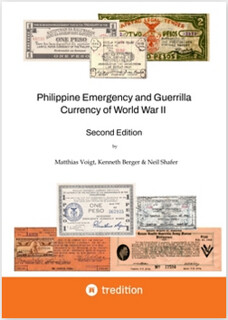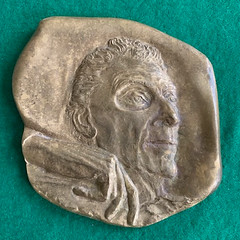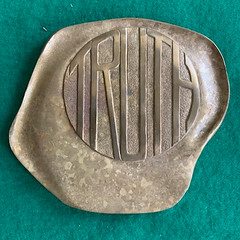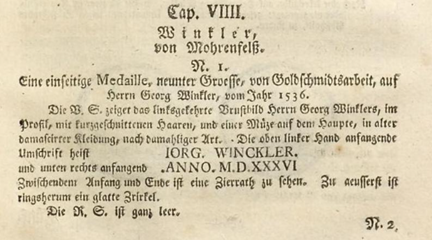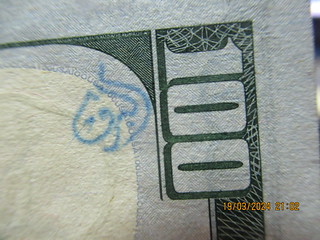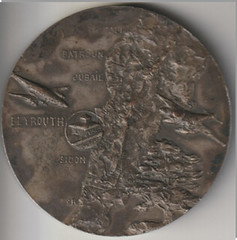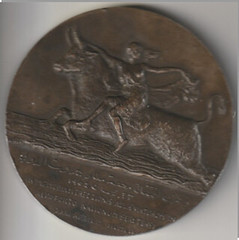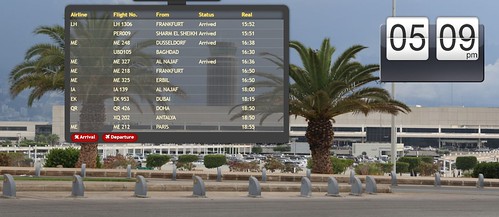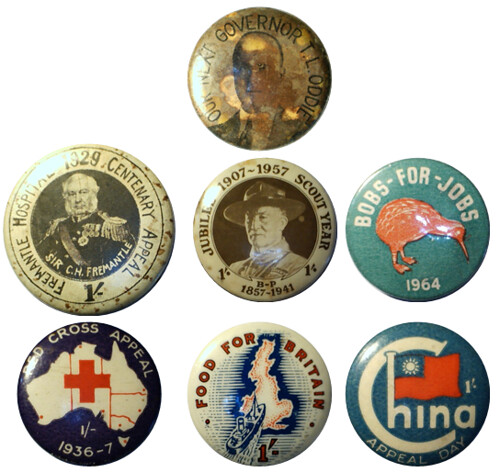
PREV ARTICLE
NEXT ARTICLE
FULL ISSUE
PREV FULL ISSUE
NOTES FROM E-SYLUM READERS: MAY 12, 2024
Philippine Emergency Currency Book Thanks "I wanted to share how delighted the Neil Shafer family is with the publication of the updated "Philippine Emergency and Guerrilla Currency of World War II". Our family is very grateful for Matthias Voigt's and Ken Berger's tireless efforts. My father worked on this project until he physically could no longer do so (up until about two weeks before he passed); this project meant the world to him and hopefully it will significantly further the understanding of this currency." Ken Berger adds: "A more detailed write up about Conrad Nielsen appeared in the 7 May 2017 E-Sylum."
To read the earlier E-Sylum article, see:
On Jane MacAdam Freud
"Among the five medals selected for the Numismagram feature, you illustrate the medal of Sisyphus "Jane was a great medallist, sculptor and artist, above all a lovely person." Thanks. -Editor
To read the earlier E-Sylum article, see:
On Wayne C. Phillips "Another great issue of The E-Sylum with another fascinating article by Pete Smith on the Phillips clan. Kudos to you both. "I knew Wayne Phillips quite well, as he was a regular advertiser in The Celator. As noted by Pete, he was both a collector and a dealer of ancient coins, and was known for his fair dealings. I would see him at the larger coin shows in Southern California, and I remember him introducing me to his father and brother at a Long Beach Expo in the late 1980s. "Wayne also enjoyed telling people that he lived in Phillips Ranch, California, and would wink if you asked him if it was named after his family. It wasn't." Thanks. Great hobby history. -Editor
To read the earlier E-Sylum article, see:
On the NASC Money Museum "Regarding the recent listing of Numismatic Museums, I am sad to report the Numismatic Association of Southern California (NASC) material was removed from the bank many years ago due to an insurance issue and the material was eventually sold. The Wells Fargo main headquarters in downtown Los Angeles on Grand Avenue has a wonderful exhibit on the main floor and is open to the public. While working nearby some years ago I looked at the front window display and saw a Wells Fargo employee award medal in the original box, but it was upside down! The medal was given to employees in 1902 who had worked for 50 years with the company (HK-296)." Pete Smith reports that the Los Angeles branch of the Wells Fargo History Museum is now closed. We reported earlier on the closure of the Philadelphia branch. However, the main San Francisco museum is still open according to its website. -Editor
For more information, see:
To read the earlier E-Sylum articles, see:
August 2024 Higgins Museum National Bank Note Seminar "The Higgins Museum will sponsor a one-day symposium on National Bank Notes on Thursday, August 1st, 2024. Five speakers will be featured, including Joe Boling, Jesse Kraft, Lee Lofthus, Cody Regennitter and Joe Ridder. "The registration fee will be $75 for participants, with a discount of $10 for members of Central States or the Iowa Numismatic Association. Registration includes morning coffee and a light lunch. The symposium will be held at the Higgins Museum, 1507 Sanborn Ave, Okoboji, IA 51355. "For additional information contact the museum curator, George Cuhaj at curator@thehigginsmuseum.org." Sounds like a great event! -Editor
More on George Winckler "At Julia's prompting, here's a translation of the description of the first medal from the scan provided: Chapter [or section] VIIII (= 9) Winckler von Mohrenfelss. [Winckler von Mohrenfels, modern spelling, is the complete family name - it still exists] N. 1 (number 1) A single-sided medal, ninth size [presumably this catalog used a size gradation system instead of precise measurements], goldsmith work, of Master Georg Winckler, from the year 1536. The obverse (V. S. = Vorderseite) shows the left-turned bust of Master Georg Winckler, in profile, with hair cut short, and with cap on head, in traditional damask (?) costume of former style. The legend (Umschrift) beginning upper left reads IORG. WINCKLER. and beginning lower right .ANNO. M.D.XXXVI (year 1536). Between the beginning and the end [of the legend], an ornament is to be seen. Outermost is a smooth circle all the way around [presumably of the edge]. "The reverse (R.S. = Rückseite) is completely blank. "The description of the second medal states that the obverse is exactly like the medal above, and that the reverse bears a coat of arms (described in detail) and a religious legend in caps at the end of the description. I haven't seen fit to translate it as it isn't germane to the woodcarved medal. "Though the blackletter typeface is relatively easy to read, some of the 18th Century spellings and word usages differ from present-day German: thus some of my translation is guesswork. In particular the underlined, question-marked word damask is likely incorrect for "damascirter," a word for which I could find no other approximation, and which is obscure in this context. "Certainly these two descriptions and the engraving relate closely to the wooden medal, and differ only in minor detail, e.g. Roman versus Arabic numerals for the year date, and the direction the subject faces." Thank you. -Editor
To read the earlier E-Sylum article, see:
An Appreciation of Paper Money Chopmarks
"I do appreciate knowing of Mr. Ratnatunga's interest in the topic area. Some of us have come to numismatics from some pretty low states of awareness and the business of chop marks sometimes might have much to do with goings on in less than perfect market conditions. Though these things aren't the usual day-job quest of numismatists, imperfect market conditions have, at least once, been the stuff of a Nobel Prize. "It's a difficult topic to write or even speak of as the bud-nipping that goes on even amongst those who should be entirely comfortable with their freedom of speech is amazing. Like activities, if referred to under the topic matter of "false coin" were of little documentation as far as I could find. "As usual, spiritual matters are difficult to speak of, but the liberating power of trade is really as important as the purchasing power of trade. Calling them "chopmarks" is one way to treat such tangentia matter-of-factly and avoid the value judgments associated with false coin rhetoric. I appreciate that. "Still, it seems like a thin ice to use the column inches of numismatics for these concerns. I am not unable to accept summaries such as "post-mint", but I do care and wanted to mention I share his concern to some extent, that extent being as intense as need be to anything that can impede my trade settlements at a spiritual level. "It shouldn't be relevant, but as I often find myself saying "This is Joe on the Shouldn't-Matterhorn." "It's good to know someone else out there notices these things." Thanks. No numismatic nits are too small to escape notice at The E-Sylum. -Editor
To read the earlier E-Sylum article, see:
Beirut-Rafic Hariri International Airport Medal "This is an art medal to commemorate the opening of the Beirut-Rafic Hariri International Airport on the 23rd of April 1954. The medal is 75 mm in diameter, weighs 260 g (very heavy!), and is bronze. I was only able to find one other medal on the Internet and it was gilded with much of the gild wearing off on one side. I reached out to some numismatists who I consider experts in art medals, but without any luck. I'm trying to find out who the artist(s) were. What mint struck the medals. How many were made and in what metal compositions. I'm hoping one of our readers might have some research on this piece. It's very important to me to know who the artist(s) were and what the interpretation was of their vision and why. For example, why was Europa on the bull (Zeus) put on one side? The other is a map of Lebanon showing the airport near Beirut with one plane descending to land at the airport, and another plane climbing presumably having just taken off from the airport. Thank you in advance for any help that is given." Can anyone help? This could be a tough one. -Editor
To visit the airport website, see:
Charity Donation Badges "The final entry of the April 21, 2024 issue was a link to a button museum. This reminded me of a few pieces in my own collection. There is no prize for guessing the reason for the Tasker Oddie badge, but then there is a whole world of charity donation badges, mostly from Australia, which are in my shilling collection, dating from the 1920s-60s. All products of their time and small pieces of social history." Some great buttons! Thanks. -Editor
To read the earlier E-Sylum article, see:
Wayne Homren, Editor The Numismatic Bibliomania Society is a non-profit organization promoting numismatic literature. See our web site at coinbooks.org. To submit items for publication in The E-Sylum, write to the Editor at this address: whomren@gmail.com To subscribe go to: https://my.binhost.com/lists/listinfo/esylum All Rights Reserved. NBS Home Page Contact the NBS webmaster 
|
